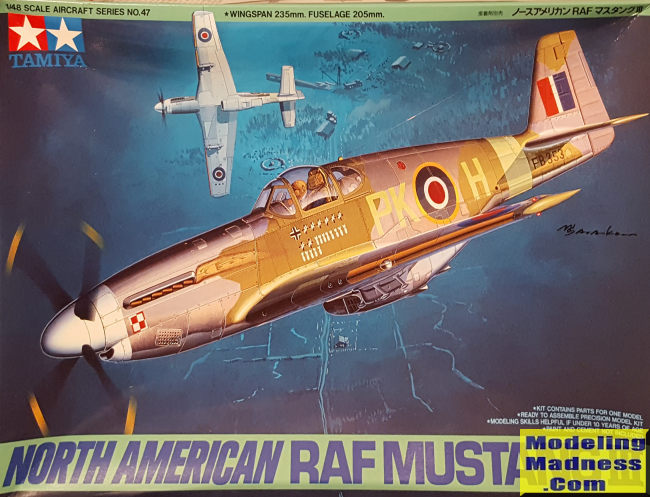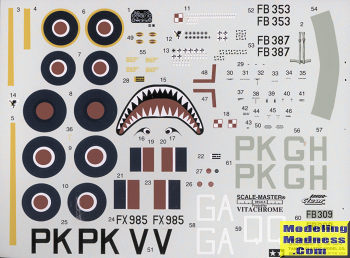
Tamiya 1/48 RAF Mustang III
| KIT #: | 61047 |
| PRICE: | 1800 yen SRP |
| DECALS: | Four options |
| REVIEWER: | Scott Van Aken |
| NOTES: | 1996 release |

| HISTORY |
The first XP-51B flew on 30 November 1942. Flight tests confirmed the potential of the new fighter, with the service ceiling being raised by 10,000 ft (3,000 m), with the top speed improving by 50 mph (43 kn; 80 km/h) at 30,000 ft (9,100 m). American production was started in early 1943 with the P-51B (NA-102) being manufactured at Inglewood, California, and the P-51C (NA-103) at a new plant in Dallas, Texas, which was in operation by summer 1943. The RAF named these models Mustang Mk III. In performance tests, the P-51B reached 441 mph (383 kn; 710 km/h) at 30,000 ft (9,100 m). In addition, the extended range made possible by the use of drop tanks enabled the Merlin-powered Mustang to be introduced as a bomber escort with a combat radius of 750 mi (1,210 km) using two 75 US gal (62 imp gal; 280 l) 2-piece, sheet-metal stamped construction drop tanks.
The range would be further increased with the introduction of an 85 US gal (71 imp gal; 320 l) self-sealing fuel tank aft of the pilot's seat, starting with P-51B-5-NA ("block 5"). When this tank was full, the center of gravity of the Mustang was moved dangerously close to the aft limit. As a result, maneuvers were restricted until the tank was down to about 25 US gal (21 imp gal; 95 l) and the external tanks had been dropped. Problems with high-speed "porpoising" of the P-51Bs and P-51Cs with the fuselage tanks would lead to the replacement of the fabric-covered elevators with metal-covered surfaces and a reduction of the tailplane incidence. With the fuselage and wing tanks, plus two 75 US gal (62 imp gal; 280 l) drop tanks, the combat radius was 880 mi (1,420 km).
Despite these modifications, the P-51Bs and P-51Cs, and the newer P-51Ds and P-51Ks, experienced low-speed handling problems that could result in an involuntary "snap-roll" under certain conditions of air speed, angle of attack, gross weight, and center of gravity. Several crash reports tell of P-51Bs and P-51Cs crashing because horizontal stabilizers were torn off during maneuvering. As a result of these problems, a modification kit consisting of a dorsal fin was manufactured, though rarely fitted to the B/C variant.
One of the few remaining complaints with the Merlin-powered aircraft was a poor rearward view. The canopy structure, which was the same as the Allison-engined Mustangs, was made up of flat, framed panels; the pilot entered or exited the cockpit by lowering the port side panel and raising the top panel to the right. The canopy could not be opened in flight and tall pilots especially were hampered by limited headroom. In order to at least partially improve the view from the Mustang, the British had field-modified some Mustangs with clear, sliding canopies called Malcolm hoods (designed by Robert Malcolm), and whose design had also been adopted by the U.S. Navy's own F4U-1D version of the Corsair in April 1944.
| THE KIT |
When Tamiya first issued this kit in 1995, it was very well received by modelers. Prior to this, the only early P-51B Mustang was the Monogram kit. Now that wasn't a bad thing as most of us are aware that Monogram 1/48 kits are ones that still build into very nice models. But Tamiya added their superb engineering and several decades of improvements in the industry to provide a kit that is still arguably the best around for this variant.
The interior is superbly done with all that most modelers need. A decal for the instrument panel and seat harness is included. What is not included compared to the P-51B boxing is a pilot figure.
Like their P-51B, the cockpit 'tub' includes the molded in radios and fuel tank along with the housing for the ventral radiator. Tamiya has added detail to the interior sidewalls that will benefit from some painting and dry-brushing. Once all that has been done, the cockpit/radiator assembly is trapped in the fuselage halves, after opening some radio mast holes. Tamiya has thoughtfully added two types of exhaust one having the covers and the other without. These can be added after painting and decalling. The upper cowling and lower intake lip are separate so no seam issues there.
When it comes to the wings, there are inserts for the large section of the gear wells. Tamiya, along with almost every other P-51 kit maker before, does not properly represent the aft gear well, having it follow the openings instead of leading straight. I believe only the current Airfix and Eduard 1/48 P-51D has this correct. Once the upper wing halves are installed, the wings and tailplanes can be added, making for a rather complete airframe. Don't forget to open the holes in the lower wings if you want the wing racks.
Tamiya has provided separate flaps and lower radiator exhaust door so you can mold those up or down. Really, most Mustangs on the ground will have lowered flaps. There is something supposedly inaccurate about Tamiya's flaps, but what it is escapes me at the moment.
There are separate wheel hubs for the outside of each wheel to help ease painting and the kit comes with diamond tread wheels. Inner main gear doors include the retraction struts while the outer doors attach directly to the struts. The tail wheel doors are molded onto the fuselage and one simply installes the one-piece tail gear/wheel.
 Tamiya chose to do the prop blades separately and you have cuffed
Hamilton Standard blades, which was the norm for the early Merlins. A
polycap hidden in the spinner allows the prop to be installed at the end
of the build. The cockpit canopy is provided in two states. One is with
the windscreen and canopy as one piece for the closed option. For the
open choice this is divided into three sections. As most British
Mustangs used the Malcom hood, that option is provided as well, though
only in the closed position. Tamiya also provides an
early and late radio mast as well as a rear view mirror for atop the
windscreen.
Tamiya chose to do the prop blades separately and you have cuffed
Hamilton Standard blades, which was the norm for the early Merlins. A
polycap hidden in the spinner allows the prop to be installed at the end
of the build. The cockpit canopy is provided in two states. One is with
the windscreen and canopy as one piece for the closed option. For the
open choice this is divided into three sections. As most British
Mustangs used the Malcom hood, that option is provided as well, though
only in the closed position. Tamiya also provides an
early and late radio mast as well as a rear view mirror for atop the
windscreen.
Four markings options are included. Three of them are in the standard mid/late war schemes of green and greys while the fourth is unpainted metal. Three of them, all with the Malcolm hood option are with Polish squadrons, specifically 315 and 316 squadrons. The lone RAF option has the shark mouth and early canopy of 112 Squadron. The decals are nicely printed and will work best with hot water.
| CONCLUSIONS |
Tamiya's Mustang III/P-51B is still the preferred choice of many modelers. It is generally accurate and won't be a fussy build. Well worth picking up.
| REFERENCES |
https://en.wikipedia.org/wiki/North_American_P-51_Mustang_variants#P-51B_and_P-51C
August 2022 Copyright ModelingMadness.com. All rights reserved. No
reproduction in part or in whole without express permission from the editor. If you would like your product reviewed fairly and fairly quickly, please
contact
the editor
or see other details in the
Note to
Contributors.